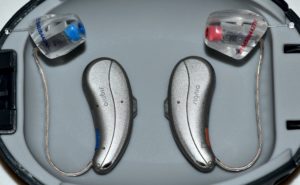If you are experiencing hearing loss, then a hearing aid could help restore your hearing by amplifying the sounds you hear and playing them back into your ear. When you first start researching hearing aids, the amount of information out there can be overwhelming, and sometimes it can also feel like every supplier has their own agenda. In this post, we’re going to take an unbiased and quick look at a few different types of hearing aids so that you can make a more informed decision about which one is right for you.
How hearing aids work
Hearing aids have three basic components, a microphone, an amplifier, and a receiver. The microphone picks up sound waves and changes them into an electrical sound that can then be detected by the amplifier. The amplifier then boosts these electronic sounds to make them louder before sending them to the receiver, which essentially acts as a speaker and converts the electrical sounds back into sound waves for the user to hear. This is a very basic explanation of how a hearing aid works. Some hearing aids have more advanced features such as wind management and noise cancellation, which can help purify the sound received by the receiver so that the user only hears what they want to hear and not amplified background noise.
Analog or digital?
 There are two key types of technology used to make hearing aids – analog and digital. Analog technology has been around for some time and so analog hearing aids are often much cheaper than their digital counterparts. That being said, analog hearing aids are generally considered to be less advanced than digital aids because they simply amplify all sounds that they hear, including background noise, which can make them less helpful in group situations or places where there are a lot of residual sounds. Digital hearing aids, on the other hand, can be programmed with a number of listening profiles and also have advanced signal processing such as noise filtering, noise reduction, and feedback control. Because digital technology is so much better than analog, the vast majority of hearing aids that you will find nowadays are digital.
There are two key types of technology used to make hearing aids – analog and digital. Analog technology has been around for some time and so analog hearing aids are often much cheaper than their digital counterparts. That being said, analog hearing aids are generally considered to be less advanced than digital aids because they simply amplify all sounds that they hear, including background noise, which can make them less helpful in group situations or places where there are a lot of residual sounds. Digital hearing aids, on the other hand, can be programmed with a number of listening profiles and also have advanced signal processing such as noise filtering, noise reduction, and feedback control. Because digital technology is so much better than analog, the vast majority of hearing aids that you will find nowadays are digital.
The four styles of hearing aid
If you’ve already started to research hearing aids, then you will have likely already come across some of these acronyms – BTE, ITE, ITC, and CIC. These acronyms refer to the style of hearing aid:
- Behind The Ear (BTE)
- In The Ear (ITE)
- In The Canal (ITC)
- And, Completely In the Canal (CIC)
The style of hearing aid that is right for you will depend on a few key factors: how severe your hearing loss is, how much you are willing to spend, whether you mind your hearing aid being seen, and the access you need to your aid.
Generally, the least conspicuous hearing aids are IIC hearing aids (Invisible In Canal) that sit right inside the ear canal. Although this style is perfect for those who do not want people to see their hearing aid, they are trickier to access than BTE aids and are also not suitable for all types of hearing loss.
Hearing aid features
Hearing aids these days are quite advanced and come with a number of great features including volume control, direct audio input, FM reception, Bluetooth, telecoil, compression, clipping, wind noise management, moisture resistance, venting, and directional microphones. Of course, the features that you choose will impact your hearing aid price, and some features may not be available on smaller in-ear models due to space limitations.
Dealing with batteries
Most hearing aids still use primary zinc-air batteries that need to be changed fairly frequently; however, some modern devices are starting to use rechargeable batteries instead, that can save time and reduce waste. Changing the battery on your hearing aid is usually a very simple process; however, if you have an in-ear device, then it can become slightly trickier. Try not to worry about changing your batteries until you’ve sat down and had a consultation with your audiologist as they will likely show you exactly how it’s done and you will realize that there is nothing to worry about.
Finding the right hearing aid for you
Hearing aids are not one-size-fits-all, and so it is crucial to speak with your audiologist about your requirements so that they can help you find the hearing aid that is right for your hearing loss and your lifestyle. There are hundreds of different hearing aids on the market, and many can be customized to suit your needs.








